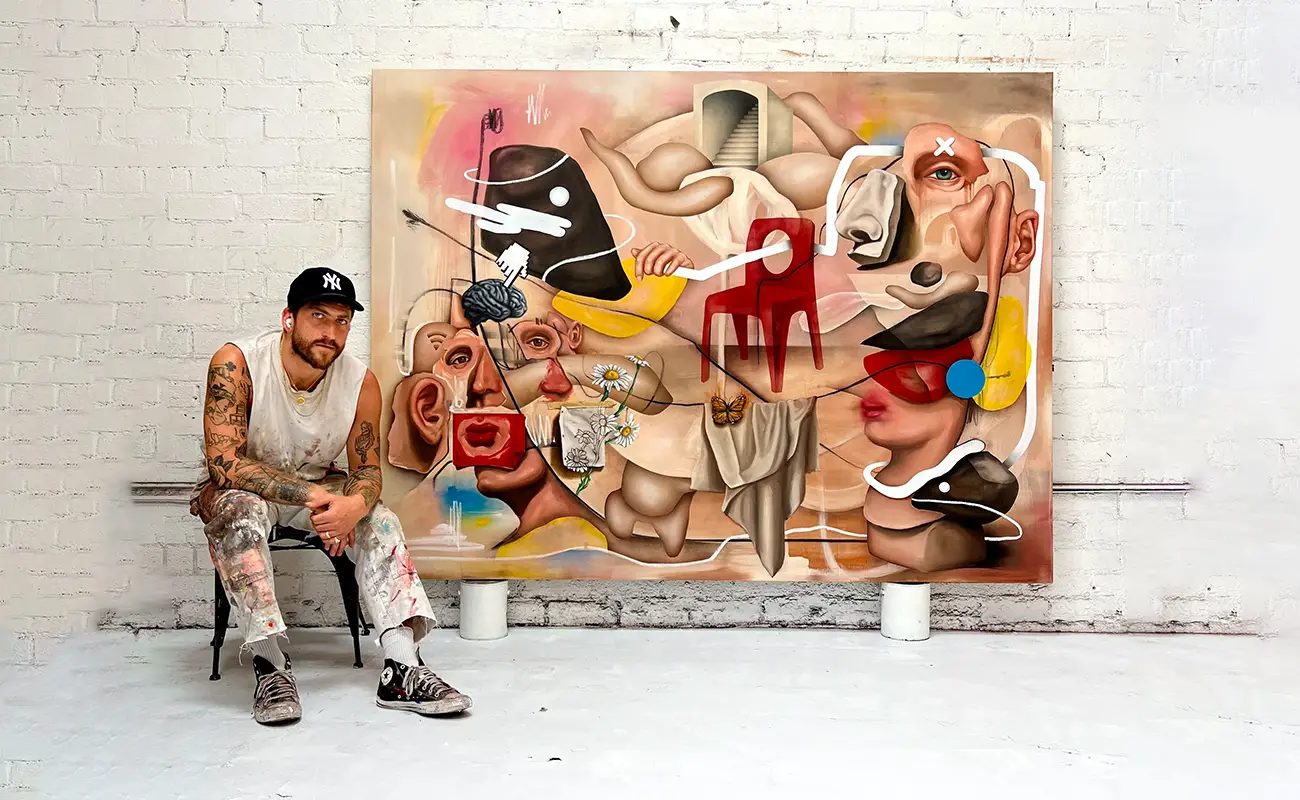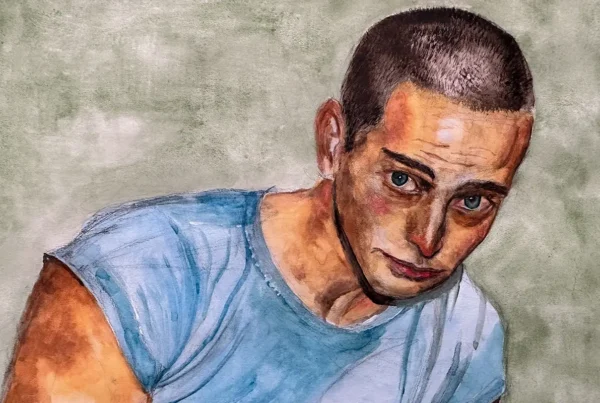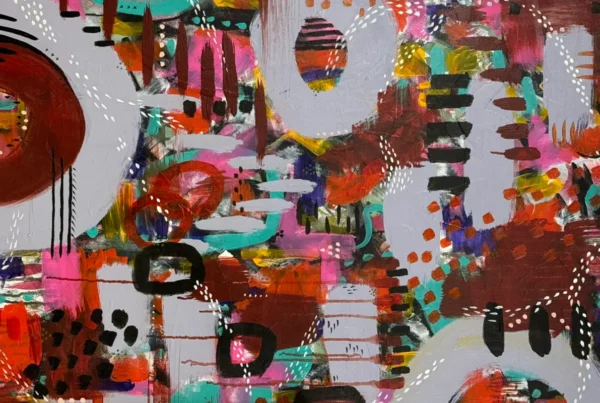Where Solitude Meets Survival
Jack Winthrop’s work is not easily separated from the story of how it came to be. A painter rooted in large-scale abstraction, his journey from the edges of society to the walls of Los Angeles galleries has shaped a body of work that is both deeply intimate and universally resonant. First introduced to the public through his debut exhibition The Wounded Healer at Gabba Gallery in October 2021, Winthrop offered more than a collection of paintings; he presented a personal narrative of resilience, addiction, and awakening. Born in 1989 in Minneapolis, Minnesota, his early years were shaped by an innate pull toward creativity, using art as a sanctuary in the midst of internal storms. Long before he became known for his expressive canvases, Winthrop was already learning to translate pain into color.
That internal tension followed him through a decade of living and working in New York City, where he graduated from the School of Visual Arts with a focus in graphic design, brand identity, and advertising. Though professionally grounded, his personal life remained turbulent. The fight with addiction, beginning at the age of twelve, was unrelenting. Moving to Los Angeles didn’t sever that pattern, and instead led him to one of the city’s darkest corners: Skid Row. Winthrop doesn’t recount this chapter for shock value, but to trace the foundation of his art. His canvases are more than visual displays—they are the records of someone who has faced annihilation and emerged with a renewed sense of self. In each painting, the shadows of that history linger, softened by the clarity that follows collapse.
In the quiet aftermath of this transformation came clarity and purpose. Now over two years sober, Winthrop’s perspective has evolved into one of gratitude, but also responsibility. His art is no longer about escaping suffering; it’s about honoring it as a source of growth. His ability to weave deeply personal moments into broader themes of disconnection, healing, and identity gives his work a resonance that stretches far beyond autobiography. Audiences don’t merely observe—they connect, often finding their own stories reflected in the chaos and calm of his compositions. For Winthrop, the brush is not just a tool, but a bridge from past to present, from pain to purpose.
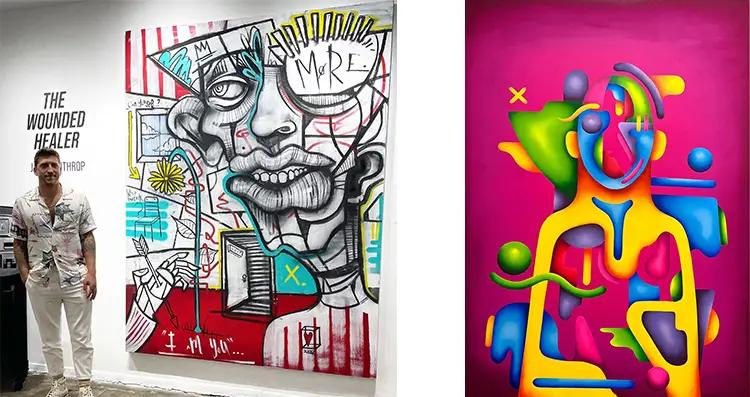
Jack Winthrop: Building Totems from Brokenness
At the core of Jack Winthrop’s current artistic output lies the TOTEMS series—an ongoing collection that signals a spiritual reawakening through visual abstraction. Each piece is born from a singular intention, whether it be humility, courage, serenity, or love. These intentions are not merely conceptual; they are embedded in every layer of paint, transforming each canvas into a living symbol of a virtue or emotional frequency. For Winthrop, the creation process begins in silence, with a centered mind and an open heart. From that place, he allows the work to emerge spontaneously, capturing the essence of the intention he carries into the studio.
What distinguishes TOTEMS is its duality: deeply personal yet widely accessible. The series doesn’t demand that viewers know Winthrop’s story, but those who do may sense the gravity behind the strokes. His use of abstraction, floral motifs, fragmented text, and kinetic lines isn’t arbitrary. These elements echo his experiences with despair, detox, and the nonlinear path to healing. Visual cues like ladders, doorways, and arrows become recurring symbols—each one a signpost from his internal landscape. These motifs invite the viewer to consider their own interpretations, offering each person a unique point of entry into the work. The paintings don’t offer resolution so much as they suggest movement, an ongoing process of becoming.
Winthrop’s belief that each piece holds an energy beyond the visual grants his work a meditative presence. There is an almost ceremonial quality to the way he speaks about his practice: the quiet before beginning, the intention behind every gesture, the belief that what is created carries a vibration into the world. His canvases feel like maps, not to a single destination, but to moments of awakening. In an era overwhelmed by distraction and detachment, TOTEMS offers viewers a pause—a chance to remember that beauty and suffering can co-exist, and that transformation is not only possible, but essential.
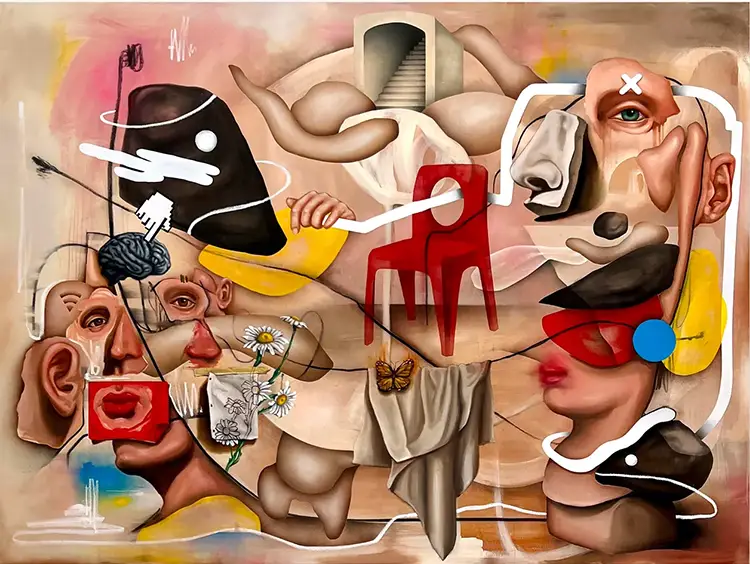
Between Flesh and Frequency
Winthrop’s compositions are less about representation and more about transformation. He often strips down the human form to its most elemental gestures, letting it dissolve into color, texture, and motion. This approach allows him to explore internal states—grief, desire, confusion, grace—without the limitations of realism. Instead of telling a story through figures, he suggests it through atmosphere. The result is a visual language that prioritizes sensation over narrative, yet still conveys the full weight of lived experience. His canvases don’t mimic reality; they evoke the surreal spaces between memory and emotion, where time stretches and collapses.
Recurring across his body of work are abstracted anatomical symbols, fractured text, and spiritual emblems that reflect an ongoing dialogue with the subconscious. By blending graffiti influences with gestural brushwork, Winthrop captures the fractured yet vibrant texture of contemporary life. The energy of his paintings is not chaotic for its own sake, but rather, mirrors the fragmented mental landscapes of those navigating loss, addiction, or identity crises. For Winthrop, the canvas becomes a site of excavation—where old selves are unearthed, scrutinized, and reformed under the weight of honesty. Each painting becomes a layered document, built through improvisation but grounded in a hard-won emotional truth.
What emerges from this process is a body of work that feels both urgent and timeless. Though rooted in personal experience, Winthrop’s exploration of isolation, recovery, and human connection speaks to larger cultural tensions. In a world increasingly dominated by digital personas and performative connection, his work points inward, urging viewers to sit with discomfort, reflect, and reconnect. The pieces offer no easy answers. Instead, they open a space for questions, for the quiet recognition that even in our most fragmented states, there is something inherently whole within us. It is this tension—between despair and hope, destruction and creation—that animates his evolving practice.
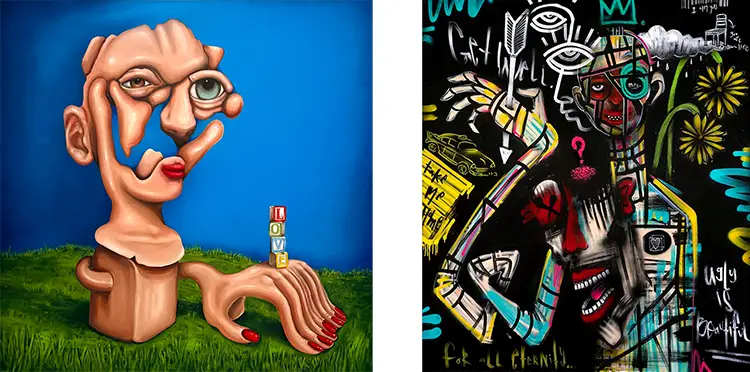
Jack Winthrop: A Life Rewritten in Color
For Jack Winthrop, every brushstroke is a step away from the life he once knew and a gesture toward a future he continues to shape. Coming back from the brink in 2019, when he found himself living unhoused and addicted to fentanyl, Winthrop has rebuilt not only his health but his artistic identity. The Wounded Healer, his debut collection, served as a visual memoir of those years spent confronting dependency, estrangement, and the raw fight for survival. The exhibition became a turning point, allowing him to reframe trauma as insight and use his past as a source of collective resonance. Rather than obscuring the dark, he confronts it directly, channeling it into color, form, and line.
His artistic process now centers around spontaneity and intuitive movement, guided not by rigid technique, but by emotional clarity. Each painting session is treated as a return to the present, as he surrenders to the marks in front of him. This practice keeps his work fluid and alive, resisting predictability in favor of raw expression. His education in design underpins his sense of balance and composition, but he intentionally allows chaos to enter the frame. This duality—discipline paired with improvisation—is what gives his paintings their visceral power. They are grounded yet uncontainable, much like the artist himself.
Despite the intensity of his subject matter, the core message in Winthrop’s work remains one of compassion. “No one is disposable,” he states—a principle that runs through every canvas. His use of recurring motifs like arrows, hearts, and doorways are not just visual choices, but markers of survival and aspiration. Whether depicting his own struggles or echoing the pain of a disconnected generation, Winthrop paints to remind us of our capacity for change. His story is not just one of personal redemption, but of artistic alchemy: turning suffering into connection, and paint into a path toward light.



